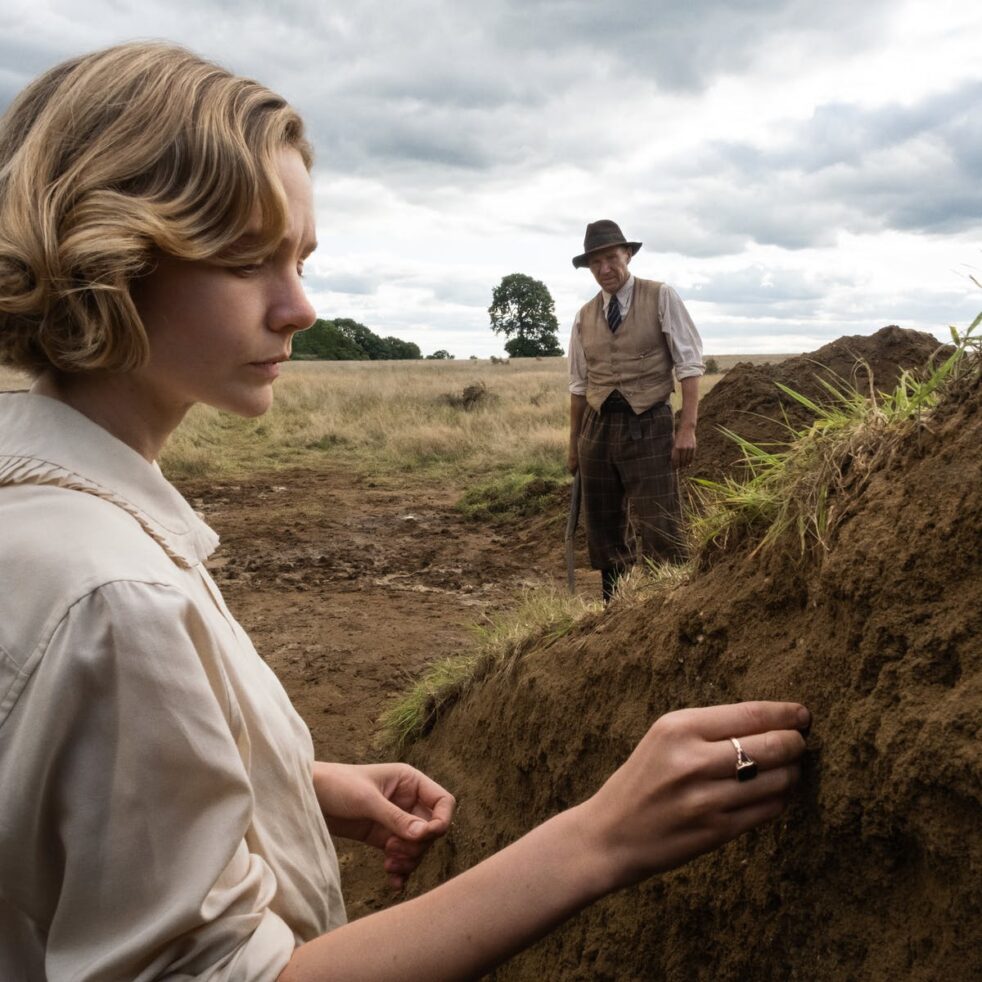Our Take: 4 Stars
“The Dig,” a historically-inspired period drama based on John Preston’s novel of the same title, is a quiet, quintessentially British story about life, love and archaeology. The film tells the true story of the excavation of Sutton Hoo in 1939, one of the most prominent archaeological finds in British history. The find was one of the first to offer insight into the so-called “Dark Ages” in Britain, and many of the artifacts unearthed are still on display at the British Museum.
In the film as in real life, the ship is first discovered by amateur archaeologist Basil Brown, played to unassuming perfection by Ralph Fiennes (“Schindler’s List”).
Brown begins the excavation at the behest of the wealthy, widowed Edith Pretty (Carey Mulligan, “The Great Gatsby”), who owns the estate of Sutton Hoo. As the drama of the excavation itself unfolds, so does the internal drama of those unearthing it — Mrs. Pretty grapples with her own mortality, while Basil must decide between his pride in his discovery and his love of it.
Once the import of Basil’s discovery becomes clear, conflict arrives in the form of archaeologists from London, eager to claim the find for themselves. Ken Stott (“The Hobbit”) plays Charles Phillips, the Cambridge archaeologist who takes over the dig. Accompanying Phillips is Stuart Piggot (Ben Chaplin, “Dorian Gray”) and his young wife Peggy (Lily James, “Mamma Mia! Here We Go Again”). The tensions between Stuart and his wife quickly become evident — the two share a bedroom, but not a bed, and Stuart seems to prefer the company of his fellow archaeologists to that of his wife.
While Stuart dallys, Peggy catches the eye of Mrs. Pretty’s dashing young cousin, Rory Lomax (Johnny Flynn, “Emma”), who arrives first to help out with the excavation and then to photograph it. As war looms on the horizon, the two engage in a tender affair that both know will be over almost as soon as it begins.
The film takes place on the cusp of World War II, and tremors of the coming conflict give it an underlying sense of urgency and tragedy. The signs of war are everywhere — RAF planes fly overhead, Mrs. Pretty sees uniformed soldiers when she goes into London — and the archaeologists hurry to finish the dig before the fighting starts.
The acting in the film is superb but understated. Fiennes and Mulligan both give delightfully no-nonsense performances as their respective characters; Mrs. Pretty and Basil Brown are bland and unperturbed on the outside to conceal the emotions that churn beneath the surface. James, who has built her career playing fresh-faced, relentlessly charming damsels, brings unexpected depth and weight to Peggy’s character. Archie Barnes (“His Dark Materials”) is irresistible as Robert, Mrs. Pretty’s young son; Flynn’s Rory Lomax is, like the rest of the film, quietly compelling.
With the gloomy, lovely British countryside as a backdrop and the coming war weighing heavily in the forefront, “The Dig” examines the tragedy of the passage of time and the meaning of what we leave behind. As history is unearthed beneath her feet, Mrs. Pretty is forced to come to terms with what it means to die while she watches Robert, who subsists more on fairytales than reality, grow up into a world about to be torn apart. Meanwhile, Peggy finds something precious and fragile with Rory, who is trying to capture it all with his camera before it passes him by.
In conclusion, “The Dig” will doubtless take its place amongst the period dramas that we all know and love as it brings the fascinating story of the Sutton Hoo excavation to a new generation and a different time.
Somewhat ironically, the film notes in the closing scene that much of Basil Brown’s contribution to the excavation went unrecognized until recently — if nothing else, “The Dig” serves to remedy that. More importantly, though, it explores the concepts of history, time and mortality, hoping to find within them a reason to hold on.
As Brown himself says in the film, “That speaks, doesn’t it? The past?”
“The Dig” is streaming on Netflix now.
